Tongue Diagnosis – Flashcards
Unlock all answers in this set
Unlock answersquestion
What are the characteristics of a *normal tongue*?
answer
NORMAL TONGUE -Has spirit -Pale Red -Thin white coat that is rooted and evenly distributed -Smooth -Has motility, moves easily, is supple -No trembling or unintended movement -Is moist -Fits easily in mouth -No cracks or markings or sores -No curling -No distended sublinguals
question
What are some examination conditions to take into consideration?
answer
-Natural lighting is best. -Should be extended with ease, not too forcefully. -Tongue should not be extended for long periods. If extended for too long will change color. -Inquire if patient brushes tongue -Determine if they have eaten anything shortly prior to examination -Inquire about medications
question
What effect might antibiotics have on the appearance of the tongue?
answer
Peeled in patches, due to injury to stomach yin.
question
What effect might oral steroids have on the appearance of the tongue?
answer
Red and swollen after one month. Inhaled steroids have the same effect, just takes a bit longer to show.
question
What effect might brochodilators have on the appearance of the tongue?
answer
Red tip
question
What effect might anti-inflammatories have on the appearance of the tongue?
answer
Red spots, and possibly eventually result in peeling
question
What effect might chemotherapeutic have on the appearance of the tongue?
answer
Dark, peeled coats, limp/withered tongue
question
Based on the 3 jiao correlation, the front of the tongue closer to the tip corresponds to which jiao? Which type of conditions may they reflect more of?
answer
Upper Jiao. It may indicate more exterior conditions that are manifesting on the tongue.
question
Based on the 3 jiao correlation, the back or root of the tongue corresponds to which jiao?
answer
Lower Jiao.
question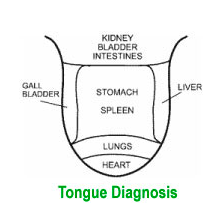
Based on the correlation of specific organ systems, where is each organ system reflected?

answer
Tip = Heart Next zone = Lung Middle zone = Spleen Middle zone = Stomach Patient Right Side = Gall Bladder Patient Left Side = Liver Root = Intestines, Bladder, Kidney
question
Does the tongue mostly reflect interior or exterior conditions?
answer
Interior
question
If the *tongue body is pale*, what does that indicate?
answer
*Blood vacuity* OR *yang vacuity*. If Yang vacuity, often bluish hue.
question
If the *tongue body is dark red*, what does that indicate?
answer
Heat excess or vacuity
question
If the *tongue body is scarlet*, what does that indicate?
answer
FIRE
question
If the *tongue body is purple*, what does that indicate?
answer
STASIS bluish purple = cold stasis reddish purple = blood stasis
question
If the tongue body is *THIN or SHRUNKEN*, what does that indicate?
answer
Deficiency of the yin substances, either blood or fluids. The consistency of the tongue body derives from a normal supply of body fluids to the tongue. The fluids give it body. A thin tongue body therefore always suggests blood/fluid deficiency. Sometimes the tongue can be so thin as to actually be shrunken, leaving longitudinal ridges on its surface.
question
If the tongue body is *THICK or SWOLLEN*, what does that indicate?
answer
Too much fluid accumulating in it. This can occur for two different reasons: either the *yang qi is deficient* and fails to transform and transport the fluids, which accumulate in the tongue; or there is *heat in the body*, which pushes the fluids up to the tongue. The former is a passive process whereby fluids stagnate; the latter is more of an active process.
question
If the tongue body is *SWOLLEN and PURPLE*, what might that indicate?
answer
Alcoholism with retention of damp-heat. This is called the "alcoholic toxin within".
question
Swelling may be due to excess or deficiency. How might you differentiate?
answer
Evaluate color of the tongue body: Pale, the swelling is from deficiency Red or purple, the swelling is from excess
question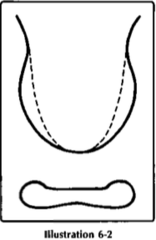
If the tongue body is *SWOLLEN at the EDGES*, what might that indicate?

answer
Spleen qi deficiency or Spleen yang deficiency. If Spleen yang deficiency, the edges will also be wet.
question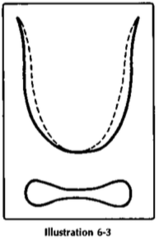
If the tongue body is *SWOLLEN at the SIDES*, what might that indicate?

answer
Rising Liver yang or Liver fire. In these cases the tongue body will clearly be red, dark red or purple (if there is also blood stasis). This type of swelling is found in a thin strip along the entire length of both sides of the tongue. This tongue differs from that with swollen edges in that the swelling is more evenly distributed along the length of the tongue body, and extends less deeply into the central tongue surface.
question
If the tongue body is *SWOLLEN at the TIP*, what might that indicate?
answer
HEART is indicated. Red or dark red tongue body = blazing Heart fire Normal tongue body color = deficiency of Heart qi Blazing Heart fire: Thirst, a bitter taste in the mouth, insomnia, irritability, a feeling of being overly warm, redness of the face, mouth or lip ulcers and an overflowing, rapid pulse. Heart qi deficiency: Palpitations, short- ness of breath after exertion, a pale complexion and a weak or empty pulse.
question
If the tongue body is *swollen BETWEEN TIP and CENTRAL surface*, what might that indicate?
answer
LUNG is indicated. *Deficiency of Lung qi with retention of damp-phlegm in the Lungs*. Commonly found in chronic conditions of Lung qi and Spleen qi deficiency, which lead to the formation and accumulation of phlegm in the Lungs. S&S: Feeling of constriction in the chest (i.e., a feeling of suffocation or an uncomfortable feeling in the chest that the patient will find difficult to describe), perhaps a cough with abundant white sputum, poor appetite, shortness of breath, lethargy and a pulse that is empty or slightly slippery, or fine and slippery.
question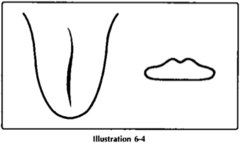
If the tongue body is *SWOLLEN along a CENTRAL CRACK*, what might that indicate?

answer
Red = Heart fire Normal = Heart qi deficiency. Heart is dilated in both cases, usually due to severe overwork and constantly pushing oneself. S&S of Heart fire or Heart qi deficiency and the patient will have marked shortness of breath, a sense of constriction in the chest and an overflowing Heart pulse.
question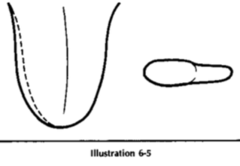
If the tongue body is *SWOLLEN on Half of the Tongue*, what might that indicate?

answer
*Qi and blood deficiency in the channels* of that side of the body is usually indicated. Due to progressive mal-nourishment of the channels from Stomach and Spleen deficiency, or to injury of the channels after a prolonged febrile disease. In both cases, it is like a mild form of atrophy disorder, affecting only the channels. S&S: Weakness on one side of the body (which could involve slight weakness of a leg or of the strength of grip in one hand), and a feeling of "pins and needles" or numbness on one side of the body. The needling sensation is difficult to obtain on the same side as the swelling of the tongue.
question
If the tongue body is *HIGHLY LOCALIZED SWELLING on ONE SIDE*, what might that indicate?
answer
Deficiency or stagnationof qi in the part of the body corresponding to the swollen area. Normal tongue body color = qi deficiency Red tongue body color = qi stagnation
question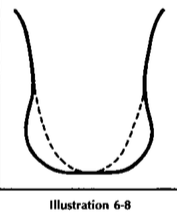
If the tongue body is *swollen and HAMMER-SHAPED*, what might that indicate?

answer
Indicates a serious deterioration of the body's nutrient substances and energies. Often indicative of mental illness. Arises after many years of pathological change. It usually reflects a serious deficiency of Spleen and Stomach qi. The causes of this condition are overwork, irregular eating, and going back to work soon after eating, and excessive sexual activity over many years.
question
A *stiff tongue* due to an acute condition, might present as...
answer
Signs of intense heat, manifesting in high fever and delirium; red or dark red tongue body (Invasion of the Pericardium by heat.) Delirium and slurred speech or aphasia may appear because the Heart is the "residence of the spirit" and controls the tongue muscle.
question
A *stiff tongue* due to an chronic condition, might present as...
answer
Intense heat has injured the body fluids and led to malnourishment of sinews, muscles and channels. Tongue body is dry and red or dark red tongue.
question
A *stiff tongue* that not red but *pale or of normal color*, might indicate...
answer
Presence of internal wind. Frequently seen in patients who have suffered an attack of wind-stroke (a diagnosis which often overlaps with that of cerebral vascular accident in modern biomedicine) and have hemiplegia with or without asymmetry of the face. Wind-stroke, from the perspective of Chinese medicine, is caused by the stirring of Liver wind in combination with other factors. The stiff tongue can also appear before an attack of wind-stroke, in which case it is a useful prodromal sign together with numbness of the first three fingers of one hand. Extreme internal heat can stir the Liver and give rise to internal wind.
question
What do all types of *FLACCID* tongues indicate?
answer
Deficiency of *BODY FLUIDS*. "When the muscles are soft, the tongue is flaccid"
question
What does a "LONG" tongue indicate?
answer
Presence of heat and will therefore also be red. It is usually associated with heat in the Heart and, from the perspective of Chinese medicine (but not modern biomedicine), indicates a constitutional tendency to Heart problems. Long and red and the tip is swollen and redder than the tongue body, the presence of phlegm and fire in the Heart is indicated. A person with this condition will tend to frequently extend and withdraw the tip of their tongue, somewhat in the manner of a snake. Other clinical manifestations include insomnia, mental restlessness, incoherent speech, uncontrolled laughter, redness of the face, dryness of the mouth, thirst, mouth ulcers, dark yellow urine and a rapid, full and overflowing pulse.
question
What does a *SHORT* tongue indicate?
answer
A short tongue cannot be fully extended from the mouth and appears to be contracted. *Due to deficiency or excess.* Internal cold stiffens the sinews and muscles so that the muscles controlling tongue movement cannot extend it, or because excess heat exhausts the body fluids so that the tongue lacks the suppleness to be extended from the mouth. Four types of short tongues: pale and short, red and short, deep red, dry and short, and swollen and short.
question
What does a *CRACKED* tongue indicate?
answer
Depends on the tongue body color, the location of the cracks and their shape and depth. The most common cause of cracks is *dryness from exhaustion of the body fluids or yin*.
question
What does a *DEVIATED* tongue indicate?
answer
Presence of *WIND*, which can be external or internal. Usually (but not always) found in conjunction with asymmetry of the face. External wind can invade the channels of the face and cause facial paralysis, with deviation of the mouth, inability to raise the eyebrows and sometimes devi- ation of the tongue when it is extended. Internal wind has an entirely different origin and nature. It usually derives from deficiency of Kidney yin and hyperactivity of Liver yang, but it may also result from deficiency of Liver blood. S&S: tremor, tics and spasms, dizziness, numbness and deviation of the tongue. Wind-stroke is always associated with internal wind, although there are other pathological factors involved. Internal wind may affect only the channels, in which case there is no loss of consciousness, but merely an often-passing impairment of movement in a limb and numbness. When internal wind affects the Organs there will be sudden loss of consciousness and other disturbances, followed by hemiplegia and asymmetry· of the face. In either case, the tongue can be deviated.
question
What does a *QUIVERING* tongue, characterized by rapid movements of small amplitude when extended, indicate?
answer
Most often pale or pale red = qi and blood deficiency, usually accompanied by Spleen yang deficiency. If red and dry = extreme heat inside, which gives rise to internal wind. If deep red and flapping tongue = Liver heat toxin generating internal wind. If accompanied by aphasia or dysphasia = collapse of Heart and Spleen qi. Pale and flaccid = collapse of the yang from profuse and protracted sweating. In this situation the sinews and channels lose the nourishment of the yang qi and the moistening of the body fluids.
question
What does a "rolled under" tongue indicate?
answer
A rolled tongue always = heat in the Heart Rolled under = there is deficiency heat.
question
What does a "rolled over" tongue indicate?
answer
A rolled tongue always = heat in the Heart When the tip is rolled over = heat from excess.
question
What does a "SCALLOPED" tongue indicate?
answer
Spleen qi deficiency Tongue body is usually pale or normal
question
What does aN "ULCERATED" tongue indicate?
answer
Swollen, painful red ulcers with red rims on the surface of the tongue usually signify *Heart fire blazing upward*. If the ulcers have a white edge, Heart heat from Kidney yin deficiency may be indicated. If the ulcers are underneath the tongue body, they are caused by extreme heat in the Spleen and Kidneys that is exhausting the body fluids.
question
What does a "SORE-COVERED" tongue indicate?
answer
They usually indicate heat in the upper burner and are most frequently attributed to *heat toxin in the Heart channel.* Looks like rice grains scattered on the four comers of both its upper and lower surfaces. The sores may or may not be painful. Convex and painful = heat toxin in the Heart blazing upward Concave and painless = yin deficiency of the lower burner, with heat from the deficiency floating upward



